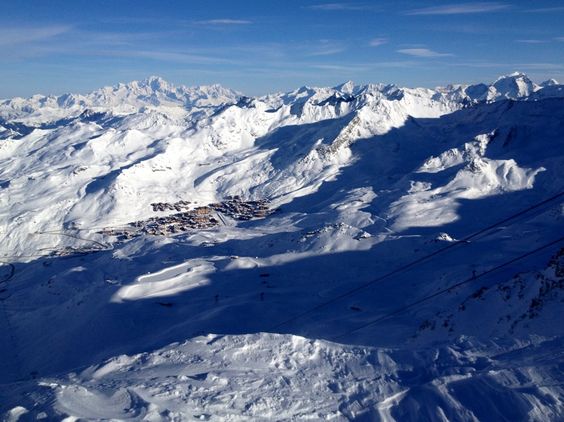 Val Thorens, located in the Tarentaise Valley, Savoie, French Alps, is the highest ski resort in Europe,[1] at 2300 m altitude. It is located in the commune of Saint-Martin-de-Belleville in the Savoie département. The resort forms part of the 3 vallées linked ski area which, with over 600 km of piste, is the largest linked ski area in the world.
Val Thorens, located in the Tarentaise Valley, Savoie, French Alps, is the highest ski resort in Europe,[1] at 2300 m altitude. It is located in the commune of Saint-Martin-de-Belleville in the Savoie département. The resort forms part of the 3 vallées linked ski area which, with over 600 km of piste, is the largest linked ski area in the world.In the 1960s the potential of Val Thorens to be transformed from summer pasture into a location for a purpose built ski area was noted. Prior to this the development of Les Menuires at 1850m was begun in 1967. In 1969 the access road was extended up to Val Thorens so that development of the resort could start. In 1971 the first of 3 drag lifts was installed, followed in 1972 by the opening of the first ski school. Like many 1960s purpose built resorts in the French Alps, Val Thorens suffered from a lack of architectural guidelines in the early days, leading to an over-dependence on concrete. New and renovated developments now have to meet much stricter design guidelines and the use of traditional materials is sought.
Given the high altitude of Val Thorens and the Glacier de Péclet the often large volume of snow means that the resort is usually open from mid-November until early May. The highest ski-able peaks are Pointe du Bouchet (3220 m) and Cime de Caron (3200 m), with its cable car of the same name, one of the biggest in the world with a capacity of 150+1 passengers.
Many of the slopes in Val Thorens face north and north-west, providing for good snow conditions. This means that the slopes are not as sunny, so the resort tends to attract a crowd more interested in skiing than "terracing". However, the resort itself faces south, and many people enjoy sitting outside in the sunshine when they have finished skiing. Val Thorens has a total of 68 marked runs, and several terrain parks. The main snow park sees top level freestyle competitions every winter as it hosts a stage of the national SFR Slopestyle Tour, and the ski cross arena is frequently visited by the FIS Skier X World Cup. Jean-Fred Chapuis, who won the Skier X event at the 2014 Olympics in Sochi, hails from Val Thorens and the ski cross track is named after him.
Val Thorens is the most visited international ski resort in France: more than 70% of its visitors are foreigners. While one will find people from all over the world in Val Thorens, British, Scandinavian, Belgian, Dutch and German tourists make up the majority.
Val Thorens is part of the 3 vallées ski domain, which is connected by a common ski pass. Jean Beranger set up the first ski school in Val Thorens: The ESF, and the Club des sport and the Tourism Office in 1972. Beranger is a former coach of the French women's ski team. He is now deputy mayor and president of the tourist office, and one slope in Val Thorens is named after him.












Comments
Post a Comment